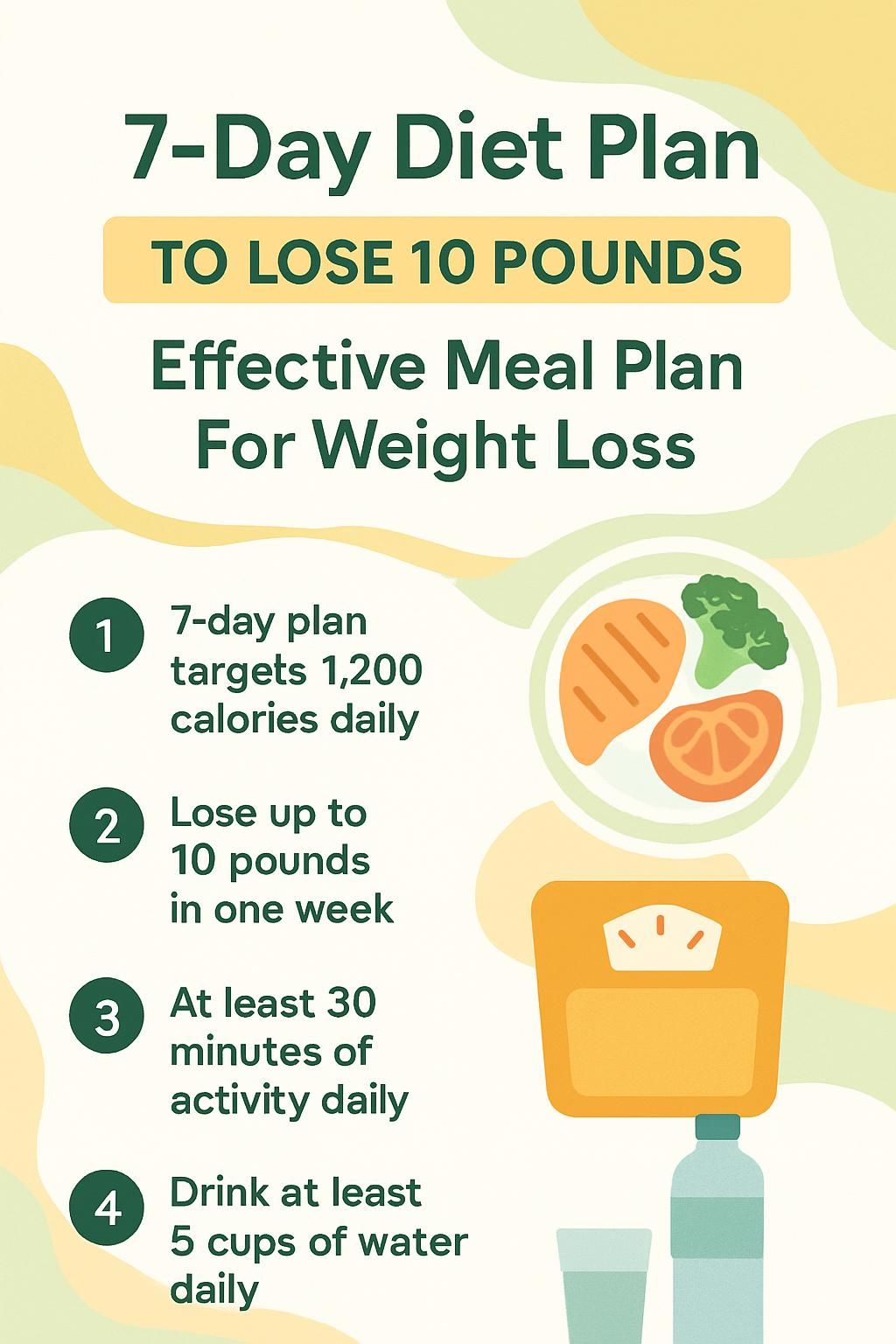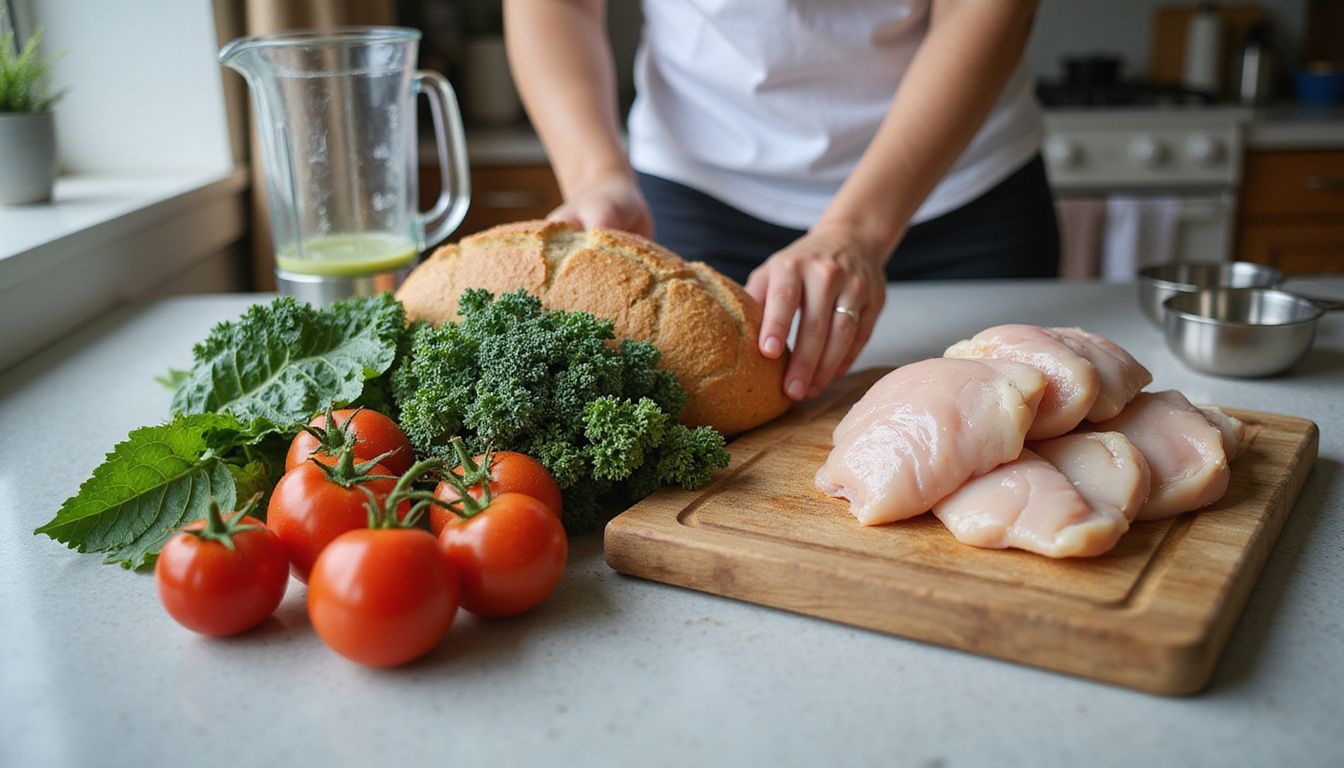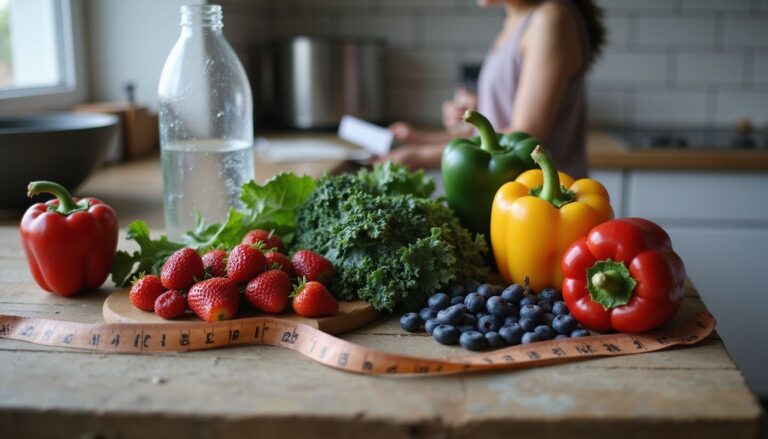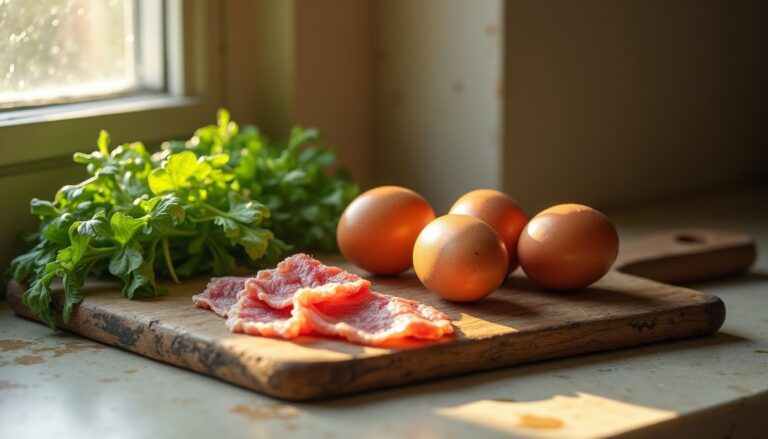7-Day Diet Plan To Lose 10 Pounds: Effective Meal Plan For Weight Loss
Our Nutrition Assistant AI Suite will transform your body. You will lose fat, get toned, and build muscle. Gain confidence and optimal health.
You want fast results, yet you also want a plan that feels doable. This simple 7-day diet plan uses balanced meals and a clear structure to help you lose weight safely. It shows you what to eat, how much to eat, and how to prep ahead so sticking to a meal plan feels easier.
This approach centers on whole foods, portion control, and calorie awareness. You will see how to build filling plates with fiber, lean protein, and healthy carbs. Ready to see how this weight loss plan comes together for the week?
Key Takeaways
- The 7-day diet plan, created by Victoria Seaver, M.S., RD of EatingWell.com, averages about 1,200 calories per day with high-fiber meals.
- Structured portions and balanced nutrition from whole grains, lean protein, and vegetables can help you lose up to 10 pounds in a week, though results vary.
- The Mayo Clinic Diet reports a typical loss of 6 to 10 pounds within two weeks during its Lose It! phase, based on a calorie deficit.
- Daily movement, at least 30 minutes, plus at least eight cups of water, supports appetite control and steady progress.
- Speak with a healthcare professional before starting a restrictive eating plan to make sure it fits your needs.

Overview of the 7-Day Diet Plan

This 7-day meal plan gives you a clear, step-by-step path for rapid weight loss. It guides your choices for a full week and shows how to pair smart portions with satisfying foods.
What is the 7-Day Diet Plan?
A 7-day diet plan is a one-week schedule that structures every meal to target quick results. This version lands near 1,200 calories per day, which creates a calorie deficit, the gap between what you eat and what you burn.
Victoria Seaver, M.S., RD, designed a simple layout with specific breakfasts, lunches, and dinners. The plan highlights high-fiber choices like whole grains and vegetables and includes lean protein from foods such as Greek yogurt and cottage cheese.
Each day uses nutrient-dense recipes and portion control to keep calories in check. Fresh ingredients, straightforward prep, and varied menus make it easier to stay on track for the full week.
How does the 7-Day Diet Plan help you lose 10 pounds?
Eating around 1,200 calories a day can create a strong deficit, which is the main driver of fat loss. High-fiber foods, such as vegetables and fruit, plus lean proteins like chicken and fish, help you feel full longer with fewer calories.
The Mayo Clinic Diet shows average losses of 6 to 10 pounds in two weeks during its early Lose It! phase. This supports short-term changes paired with daily activity. Aim for at least 30 minutes of movement each day for better results.
Balanced meals make portion control easier and reduce overeating. Sticking to this plan kept my energy steady, which made daily workouts more likely for me.
Choosing whole foods instead of processed snacks helped me stay satisfied without extra calories.
Key Principles of the Meal Plan
These simple rules help you make smart choices every day. Think of them as your checklist for a healthy and sustainable weight loss plan.
What is a calorie deficit and why does it matter?
A calorie deficit happens when you eat fewer calories than you burn. Your body then uses stored fat for energy, which leads to weight loss. For many adults, maintenance is roughly 1,500 to 2,000 calories per day, so 1,200 calories can create a meaningful deficit.
Safe weight loss usually lands at 1 to 2 pounds per week. That often requires a daily deficit of about 500 to 1,000 calories. Logging food helped me keep a steady deficit and protect my progress.
Why is balanced nutrition important for weight loss?
Balanced meals include protein, healthy fats, and dietary fiber at each sitting. Protein supports muscle and helps control hunger. Fiber from beans, whole grains, and fruit slows digestion, which also aids fullness.
Healthy fats from nuts, seeds, and olive oil support your metabolism and help curb cravings. Plenty of vegetables and fruit add vitamins, minerals, and water, so you feel full while staying within your calorie target.
Research links higher fiber and lean protein to lower calorie intake over time. This means fewer energy crashes and less snacking on processed food.
Balanced meals help you lose weight while protecting your health for life.
How does hydration affect your weight loss?
Water supports fullness and makes portion control easier. Swapping one can of soda for water can save about 150 calories. If you do that daily, those savings add up across the month.
Hydration also helps your body read hunger signals more clearly. Drinking water with meals can slow your pace, which improves fullness cues. Many people find that eight cups a day, or more if active, helps manage cravings and energy.
Sample 7-Day Diet Plan
Use these daily ideas as a template. Adjust portions to your needs, then apply the same pattern across the week.
What does a high-fiber day look like?
Focus on whole grains, legumes, and produce. A sample day can reach about 34 grams of fiber with around 1,203 calories. That day might include bran flakes, a whole wheat pita with hummus and roasted peppers, broccoli, and fruit.
Approximate day totals: 66 grams protein, 177 grams carbs, and 32 grams fat. Eating this way kept me full and helped me stay inside my calorie goal without nagging hunger.
What should you eat for breakfast on Day 1?
Try 3/4 cup bran flakes with 1 cup fat-free milk and a sliced banana. This breakfast stays under 300 calories and supplies fiber, protein, and potassium. It digests slowly, so energy feels steady until lunch.
High-fiber breakfasts are linked with better appetite control. That makes it easier to avoid mid-morning snacking.
What is a healthy lunch option for Day 1?
Fill a mini whole wheat pita with 3 ounces lean turkey, half a roasted pepper, 1 teaspoon low-fat mayo, a little mustard, and crisp lettuce. This mix balances protein and fiber for steady energy.
Pair with a part-skim mozzarella stick and two kiwis for calcium, vitamin C, and more fiber. Expect roughly 290 calories. You can also swap in a veggie niçoise pita if you prefer a plant-forward twist.
What are good dinner choices for Day 1?
Bake 4 ounces of flounder using a simple lemon-herb seasoning. Add 1 cup couscous for whole-grain carbs and 1 cup steamed broccoli for fiber and vitamins. If you like dessert, choose a single-serve ice cream to keep portions in check.
This plate combines lean protein, vegetables, and grains, which supports fullness through the evening without overshooting calories.
What are protein-packed meal examples for Day 2?
Start with 1 or 2 hard-boiled eggs at breakfast. For lunch, a veggie burger and a cup of vegetable soup bring plant protein and fiber. For dinner, barbecue cutlets offer lean protein with about 265 calories per serving.
Snack on 1 ounce of Cheddar cheese or another hard-boiled egg if needed. My Day 2 averaged about 45 grams of protein. Eating more protein helped me stay full and made workouts feel easier.
What breakfast supports weight loss on Day 2?
Blend a smoothie with 1 cup frozen berries, half a banana, and 8 ounces low or fat-free milk. Add 1 to 2 hard-boiled eggs for extra protein. This breakfast is about 271 calories, so it fits a calorie deficit while staying satisfying.
Prepping ingredients the night before makes busy mornings simple.
What lunch is ideal for Day 2?
Choose 1 cup vegetable soup and a veggie burger on a slice of whole grain toast. Add 1 cup grapes for a fresh, hydrating side. This mix supplies fiber from the soup and toast, plus protein from the burger patty.
The result is a balanced lunch that steadies appetite and supports your afternoon energy.
What dinner fits Day 2’s protein focus?
Pick barbecue cutlets and add citrus slaw or sautéed spinach with garlic, olive oil, and tomatoes. Include half a baked potato or sweet potato for slow-digesting carbs. These sides boost fiber and flavor without many calories.
I found this dinner filling and easy to cook on a busy night.
How to enjoy low-calorie comfort meals on Day 3?
Go for 4 ounces steamed shrimp with a baked potato, topped with 3 tablespoons salsa and 1 tablespoon Greek yogurt. Add 3 cups steamed spinach for volume and nutrients. You can land near 1,190 calories for the day with about 59 grams protein, 35 grams fiber, and 36 grams fat.
For dessert, choose an ice cream bar or 1 ounce of chocolate, about 100 to 150 calories. Sodium can stay moderate near 1,534 milligrams with these choices.
What is a suitable breakfast for Day 3?
Cook 1/2 cup quick oats in low-fat milk or unsweetened soy milk. Top with half a sliced apple, 1 teaspoon honey, and a sprinkle of cinnamon. This bowl delivers fiber and slow-release carbs that help control hunger through the morning.
Next, build a lunch that keeps energy steady without extra calories.
What lunch works well on Day 3?
Make chicken salad using 4 ounces shredded, skinless roast chicken. Stir in one-fourth cup red grapes, one tablespoon slivered almonds, and one-fourth cup chopped celery. Combine with one tablespoon mayonnaise and one tablespoon Greek yogurt for a lighter creamy texture.
Serve over lettuce with a slice of multigrain toast. This lunch has lean protein, produce, and healthy fats. It kept me satisfied all afternoon without feeling sluggish.
What dinner options are best on Day 3?
Choose 4 ounces steamed shrimp for lean protein. Add a baked potato with salsa and Greek yogurt instead of butter or sour cream. Include 3 cups steamed spinach for a filling, nutrient-rich side.
Finish with a small dessert, such as 1 ounce chocolate or a 100 to 150 calorie ice cream bar. A small treat can help with long-term adherence.
How to include healthy carbohydrates on Day 4?
Start with muesli and raspberries at breakfast for steady energy. Healthy carbohydrates, also called complex carbs, digest slowly and help prevent energy dips. Round out the day with whole grains like quinoa, brown rice, or sweet potatoes.
Swapping white bread for a whole-grain English muffin once kept my focus stable all afternoon.
What breakfast boosts energy on Day 4?
Muesli with raspberries gives fiber, natural sweetness, and about 287 calories. The combination of whole grains and fruit supports steady blood sugar and morning focus. Fiber also supports digestion, which may aid weight loss.
I stayed full until lunch with this breakfast and had fewer cravings.
What lunch features healthy carbs on Day 4?
Cook quinoa and toss it with black beans, chopped spinach, roasted peppers, and sweet corn. Add lime juice, scallions, and a light olive oil and lemon vinaigrette. This bowl offers fiber and plant protein for fullness and steady energy.
Serve with crunchy coleslaw made from red cabbage, carrots, and a yogurt-based dressing. High-fiber meals like this have been linked with better appetite control.
What dinner includes healthy carbs on Day 4?
Use brown rice or whole wheat pasta as your base. Pair with roasted vegetables, such as broccoli or carrots, for added fiber and vitamins. Add grilled chicken if you want extra protein without many added calories.
One cup of brown rice plus sautéed spinach and peppers is one of my favorite Day 4 plates. It kept me full without going over my calorie target.
What are nutrient-dense meal choices on Day 5?
Start with muesli and raspberries, about 287 calories. For lunch, build a large salad with spinach, beans, tomatoes, cucumbers, and grilled chicken. Add a light drizzle of olive oil for healthy fat.
Dinner can be spinach ravioli with artichokes and olives, about 454 calories. A sample Day 5 might reach 51 grams protein, 161 grams carbs, and 39 grams fiber. I felt full longer when most of my meals came from plants.
What is a nutrient-rich breakfast for Day 5?
Muesli with raspberries delivers whole grains for lasting energy and berries for antioxidants, around 287 calories. This combo supports steady blood sugar and reduces mid-morning cravings.
When I used muesli with fruit at breakfast, I stayed on track more easily through lunch.
What lunch should you have on Day 5?
Try Chipotle-Lime Cauliflower Taco Bowls, about 344 calories. Roasted cauliflower, onions, fresh greens, and black beans provide fiber and plant protein. Lime and chipotle bring flavor without heavy sauces.
It is easy to prep this lunch in containers. Portioning ahead made it simple for me to avoid overeating.
What dinner supports nutrient density on Day 5?
Spinach ravioli with artichokes and olives offers leafy greens, fiber-rich artichokes, and healthy fats from olives, around 454 calories. This dinner feels satisfying without weighing you down.
Balanced meals like this gave me steady evening energy and fewer late-night snacks.
Next, see how a full vegetarian focus can work well on Day 6.
How to focus on vegetarian meals on Day 6?
Make all meals plant-based for the day. Use legumes and nuts for protein. For breakfast, overnight oats with peanut butter and banana provide long-lasting energy.
At lunch, a veggie and hummus sandwich is filling at about 325 calories. Dinner can be curried sweet potato and peanut soup with one slice whole-wheat baguette, about 405 calories. A sample day lands near 1,190 calories, with around 168 grams carbs, 47 grams protein, and 46 grams fat.
Prepping beans, nuts, and chopped vegetables in the morning made this day simple for me.
What vegetarian breakfast works on Day 6?
Muesli with raspberries is quick, plant-based, and about 287 calories. Whole-grain oats and fruit deliver fiber for fullness and steady energy. If you like extra texture, add a few chopped nuts.
Compared with toast or a frozen waffle, this kept me satisfied longer.
What lunch fits a vegetarian focus on Day 6?
Build a Veggie and Hummus Sandwich on whole grain bread. Spread two tablespoons hummus, then add spinach, tomatoes, cucumbers, and grated carrots. This lunch is about 325 calories and rich in fiber and plant protein.
Meals like this kept me satisfied through the afternoon without cravings.
What vegetarian dinner options are ideal on Day 6?
Choose Curried Sweet Potato and Peanut Soup with one slice whole-wheat baguette, about 405 calories. Sweet potatoes and peanuts bring complex carbs, plant protein, and healthy fats that support fullness.
High-fiber, vegetable-based dinners help maintain your calorie deficit while still feeling satisfying. Drink water with the meal to support digestion and appetite control.
What makes Day 7 meals light and refreshing?
Shift to crisp produce and lean proteins for a lighter feel. Eggs, peppers, avocado, and greens add flavor without heaviness. One example is Egg in a Hole Peppers with Avocado Salsa at 285 calories.
A sample Day 7 can reach about 1,221 calories, 47 grams protein, and 32 grams fiber with lower sodium near 1,741 milligrams. I felt satisfied and energized without feeling weighed down.
What breakfast is light and refreshing on Day 7?
Make Egg in a Hole Peppers with Avocado Salsa. Use bell pepper rings instead of bread, then crack one egg inside each ring and roast until set. Top with avocado salsa for healthy fats and bright flavor.
This meal has about 285 calories and enough protein to curb hunger. It came together fast on busy mornings and kept me full without a heavy feeling.
What lunch is ideal for Day 7?
Curried Sweet Potato and Peanut Soup works well for lunch, around 345 calories. It blends sweet potatoes and peanuts for fiber, plant protein, and healthy fats. You also get vitamins A and C plus minerals like potassium and magnesium.
This meal stays light yet filling, which supports a calorie deficit without leaving you hungry.
What dinner completes Day 7’s light meal plan?
Spinach and Artichoke Dip Pasta finishes Day 7 at about 371 calories. Whole grains from pasta, spinach, and healthy fats deliver comfort and balance in one bowl. Flavor stands on its own, so there is no need for extra sauces.
I enjoyed this dish after a long day. It felt creamy yet light, and I did not crave snacks later. Pair with water or herbal tea to support hydration.
The next section explains how this plan supports fast yet healthy progress through smart portions and food choices.
Benefits of the 7-Day Diet Plan
This plan organizes your week so you can focus on eating well and moving more. Expect a structure that reduces guesswork and supports consistency.
How does this plan promote rapid, healthy weight loss?
It creates a calorie deficit, the core driver of fat loss. Meals highlight foods to eat that keep you full, like high-fiber vegetables, lean proteins, and other nutrient-rich choices. That mix limits overeating and helps you stick to your target.
Many people lose 6 to 10 pounds in two weeks during the early phase of the Mayo Clinic Diet. Regular hydration supports appetite control and may help metabolism. I noticed a quick energy lift after a few days, which kept me motivated.
Clear portions reduce high-calorie snacking and help you maintain a steady pace that health professionals support.
How can this diet improve your energy levels?
Balanced meals with protein, healthy fats, and complex carbs help keep blood sugar steady. Fiber slows digestion and reduces energy swings. Vegetables and fruit supply micronutrients needed for daily energy.
Hydration matters too. Even mild dehydration can sap energy, so water or herbal tea can help you feel more alert. Spreading meals across the day smooths energy without spikes or crashes.
How does the plan help control portion sizes?
Each meal includes a clear calorie range and a set serving size. Breakfasts often stay under 300 calories. Lunches and dinners typically land between 300 and 500 calories.
Following these portions helps prevent overeating. Having firm guidelines made it easy for me to avoid second helpings and needless snacking.
Foods to Avoid During the Plan
Certain foods make weight loss harder. Limiting them can speed results and improve how you feel during the week.
Why avoid processed and sugary foods?
Processed snacks often pack extra calories, added sugar, and sodium with very little nutrition. Sweet drinks and candies spike blood sugar quickly, which can lead to a crash and more hunger later.
Replacing these items with whole grains, fruit, and vegetables boosts fiber and fullness. Swapping a sugary pastry for whole grain toast, for example, usually keeps you satisfied longer and steadies energy.
What are the drawbacks of fried and fatty foods?
Fried foods are calorie dense and easy to overeat. Even small portions can push you past your daily target. Greasy meals raise calorie intake and may slow progress if eaten often.
Higher intake of fried foods has been linked with heart problems and weight gain over time.1 Choosing grilled chicken or fish with nuts and olive oil supports steady weight loss instead.
1 “Fried food consumption and risk of coronary heart disease: the Spanish cohort study,” Public Health Nutrition, 2015.
Why should high-calorie snacks be limited?
High-calorie snacks can quickly push you over a 1,200-calorie goal. A small bag of chips or a few cookies often tops 150 calories. Those extras add up fast.
Pick measured snacks like 1 ounce of cheese or a hard-boiled egg. Capping dessert at 75 calories per day helps with cravings without stalling progress. Swapping sweets for fruit or a small portion of nuts made the plan easier for me.
Tips for Success
Small habits add up over seven days. Use these practical steps to make the plan stick.
How can meal prep improve your diet success?
Meal prep saves time and reduces last-minute choices. Bake Baked Banana-Nut Oatmeal Cups and you will have fast breakfasts for Days 1 through 3. Prep Chipotle-Lime Cauliflower Taco Bowls for several days and lunches stay ready from Day 2 to Day 5.
Hard-boil eggs ahead for quick protein on Days 2, 5, and 6. Store meals in airtight containers to keep food fresh. People who prep meals are more likely to follow their plan and control portions, based on a national study in 2017 from the Journal of the Academy of Nutrition and Dietetics.
Planning lowers stress during busy weeks and helps you avoid processed snacks.
What light exercises complement this diet plan?
Walk briskly for at least 30 minutes a day. Cycling, easy swimming, or yoga also work. Gentle bodyweight moves like squats, lunges, and wall push-ups support muscle while you lose weight.
Regular light activity can improve sleep and energy, and it supports steady weight reduction. A daily walk after breakfast with a short stretch before dinner kept my energy even all week. Check with a healthcare professional before starting new activity if you have any conditions.
How should you track progress effectively?
Use a food and activity journal to log meals, snacks, and movement. The Mayo Clinic Diet’s weight tracker can help you see weekly trends. Set small, realistic goals each week and adjust as needed.
Writing everything down helped me spot helpful swaps. Switching from buttered toast to whole-grain toast, for instance, showed up as a clear change over seven days.
Potential Risks and Considerations
A structured plan can be helpful, but a very low-calorie diet is not for everyone. Safety comes first.
When should you consult a healthcare professional?
Speak with a healthcare professional before you start a restrictive plan, especially if you have a medical condition. People with diabetes may need to adjust fruit portions due to carbohydrate content.
If you feel unwell, overly hungry, or have digestive issues during the week, seek advice promptly. Early guidance can prevent problems and keep you safe.
Why is avoiding over-restriction important?
Extreme calorie cuts can cause fatigue and nutrient gaps. Intakes below 1,200 calories often fail to meet basic nutrient needs for most adults, according to the National Institutes of Health.
This 7-day plan includes plenty of vegetables and fruit to help with fullness. You can also raise your daily calories to 1,300 to 1,800 if needed and still lose weight. Years ago, I tried to skip meals and felt dizzy by day three. Now I aim for flexibility and steady progress instead.
Eating a wider mix of foods can reduce cravings and improve mood, which often leads to better long-term results.
Conclusion
A 7-day diet plan can jump-start weight loss while teaching you how to build balanced plates. Focus on fiber, lean protein, and healthy carbs. Drink water often, and use simple tracking to spot what works for you.
Check with a healthcare professional before you begin, especially if you have health concerns. You can run this plan near 1,200 calories or adjust a bit higher and still lose weight. Smart habits built this week can help you keep weight off and support better health over time.
FAQs
1. How does the 7-day diet plan help with losing 10 pounds?
A structured 7-day meal plan uses calorie control and balanced nutrition to create a calorie deficit, which can lead to weight loss. Research from the National Institutes of Health shows that reducing daily intake by 500 to 1000 calories may result in about one to two pounds lost per week. This approach combines lean proteins, whole grains, fruits, and vegetables for effective results.
2. What foods are included in an effective meal plan for weight loss?
An evidence-based meal plan includes lean meats like chicken or turkey breast, fish such as salmon or cod, whole grains like brown rice or oats, legumes including beans and lentils, leafy greens such as spinach or kale, berries like strawberries or blueberries, and healthy fats found in nuts and olive oil. These choices provide essential nutrients while supporting satiety.
3. Is it safe to lose ten pounds in one week using this diet plan?
Most health experts recommend aiming for gradual weight loss of one to two pounds per week for safety and sustainability according to guidelines from the Centers for Disease Control and Prevention. Rapid weight reduction can increase risks of muscle loss or nutrient deficiencies; always consult a healthcare provider before starting any new eating pattern.
4. Can personal experience support the effectiveness of this seven-day diet strategy?
Many individuals report initial success when following a structured weekly eating schedule focused on portion control and nutrient-dense foods; however scientific studies emphasize long-term habits over short-term fixes for lasting change. For example after trying a similar program I noticed improved energy levels but maintained my progress only through continued mindful choices beyond those first seven days.
Summary: A well-designed seven-day eating routine relies on proven nutritional strategies supported by research data prioritizing both safety and sustainable outcomes over quick solutions.







